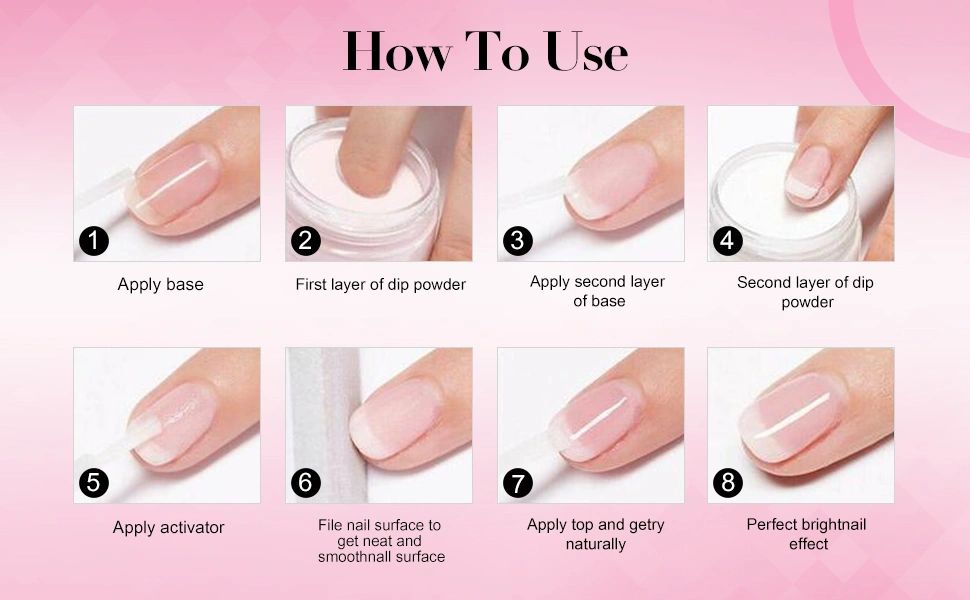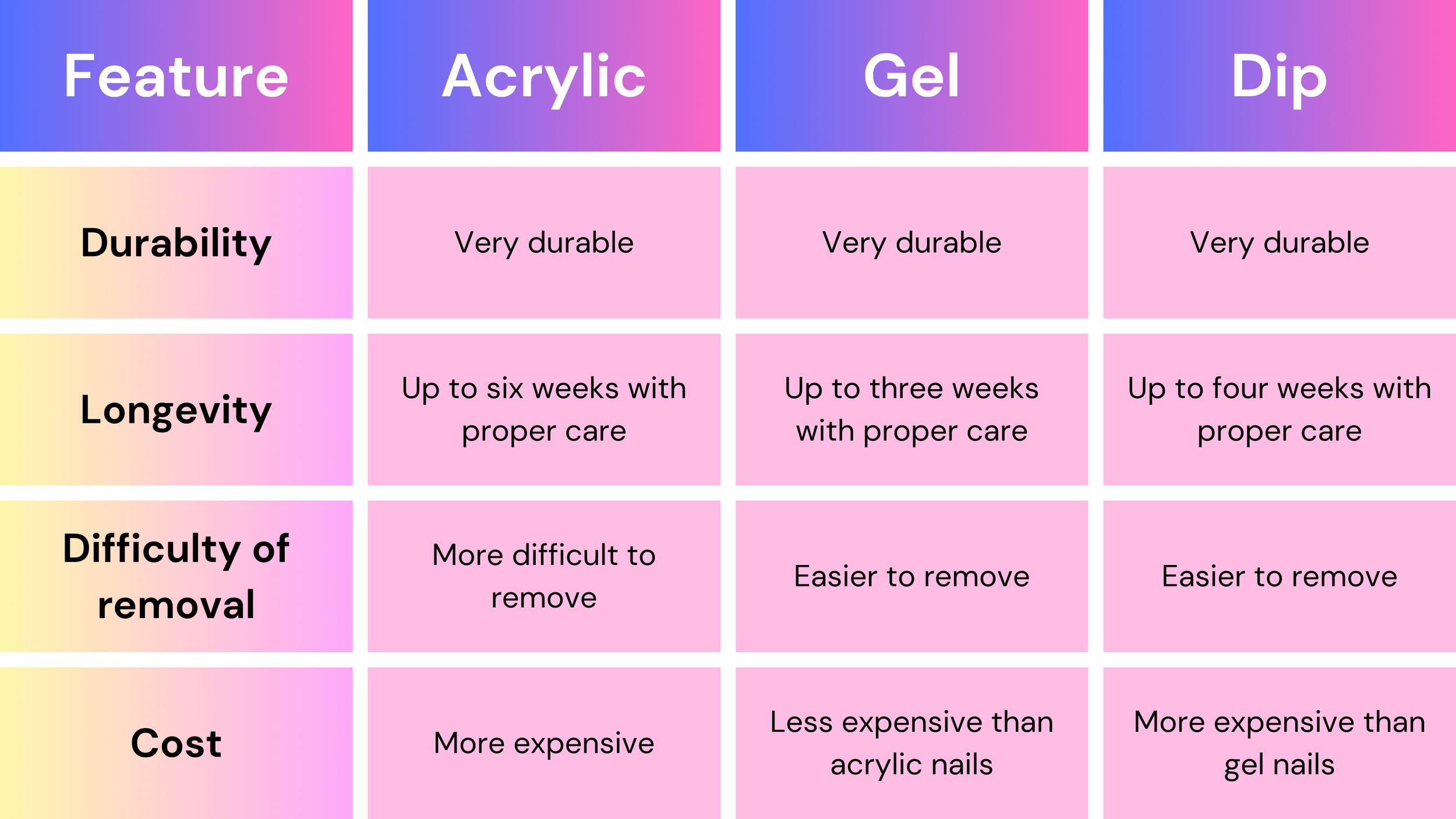Dip powder nails and acrylic nails are both popular options for nail enhancements. However, when it comes to choosing the better option for your nails, it ultimately depends on your personal preferences and needs.
While some argue that acrylic is more damaging to your nails compared to dip, the fact is that acrylic is no more harmful than a dip. Both techniques require grinding down the nails and exposure to solvents, which can potentially weaken the nails.
Therefore, it is important to take proper care and maintenance regardless of which option you choose. Ultimately, the decision should be based on factors such as durability, appearance, and personal preference.
Introduction To Nail Enhancements
When it comes to nail enhancements, the debate between Dip and Acrylic has been ongoing. Both options have their merits, but it’s essential to understand the basics before making a decision. Popularity trends in nail fashion have shown a shift towards Dip in recent years, with many individuals opting for this alternative. However, it’s crucial to weigh the pros and cons of each before determining which is better for your nails.

Credit: heathersnailboutique.com
Composition And Application
The science behind dip powders lies in their finely milled powder form, which allows for a more precise application and a lighter, more natural feel. On the other hand, acrylic nails are composed of a liquid monomer and a powder polymer that chemically react to create a hard, durable surface when exposed to air. This chemical reaction is what gives acrylic nails their strength and durability.
When it comes to the application process, dip powders are applied by brushing a bonding polish onto the nail and then dipping it into the colored powder. Acrylic nails, on the other hand, are created by mixing the liquid monomer with the powder polymer to form a bead, which is then shaped onto the nail using a brush.
Durability And Maintenance
For long-lasting and low-maintenance nails, dip powder is a better option than acrylic. Dip powder nails are durable and less damaging to natural nails, making them a healthier choice overall. With proper application and removal, dip powder nails can help maintain the strength and integrity of your nails.
| Durability and Maintenance |
| How Long Do Dip Nails Last? |
| Dip powder nails are known for their long-lasting durability. On average, dip nails can last anywhere from 3 to 4 weeks without chipping or lifting. The application process involves layering a base coat, dipping the nails into colored powder, and sealing with a top coat. This multi-layered technique creates a strong and resilient manicure that can withstand everyday wear and tear. |
| Acrylic Longevity and Upkeep |
| Acrylic nails also offer decent durability, but they may not last as long as dip powder nails. Typically, acrylic nails can last around 2 to 3 weeks before needing a fill or maintenance. The application process involves applying a liquid monomer and a powdered polymer to create a hard layer on the natural nails. While acrylic nails can be sturdy, they may be more prone to chipping or breaking compared to dip powder nails. |
Health And Safety Considerations
Acrylic nails and dip powder nails can both potentially cause damage to your natural nails. However, with proper application and removal techniques, the damage can be minimized. It is important to choose a qualified technician who follows safety measures and uses quality products. When getting nail enhancements, ensure that the salon follows proper hygiene practices. The tools and equipment should be sanitized, and the technician should wear gloves. It is also essential to take breaks between nail applications to give your nails a chance to breathe and recover. |
Aesthetics And Finishing
Choosing between dip and acrylic nails depends on your preferences and nail health. Dip nails are generally considered healthier than acrylics, as they are less harsh on natural nails during application and removal. On the other hand, acrylic nails are stronger and may be preferable for those with weaker nails.
Consider consulting with a nail technician to determine the best option for your nails.
| Natural Look: Dip vs. Acrylic |
| When it comes to achieving a natural look, dip nails are the better option compared to acrylic nails. Dip nails have a finer texture, making them appear more natural than acrylic nails. Additionally, dip nails do not require a primer or monomer, making them a healthier option for your nails. |
| Strength and Thickness Comparison |
| Acrylic nails are thicker and stronger than dip nails. If you are looking for a more durable and long-lasting option, then acrylic nails are the better choice for you. However, if you prefer a more natural and lightweight feel, then dip nails are the way to go. |

Credit: www.cuteticles.com
Removal Processes
Both dip and acrylic nails can be damaging to your nails. However, soak-off gel nails are a healthier option than acrylic nails as they are less harsh on natural nails during the removal process. It is important to take safety measures into account and choose the best option for your nails.
| Removal Processes | |||||
|---|---|---|---|---|---|
| The right way to remove dip nails: | 1. File the shiny topcoat off the nails with a nail file. | 2. Soak cotton balls in acetone and place them on top of each nail. | 3. Cover the cotton balls with foil and wait for 10-15 minutes. | 4. Use a cuticle pusher to gently push off the dip powder. | 5. Buff and shape the nails to remove any remaining dip residue. |
| Taking off acrylics safely: | 1. File the topcoat and any embellishments off the nails with a nail file. | 2. Soak cotton balls in acetone and place them on top of each nail. | 3. Cover the cotton balls with foil and wait for 30-45 minutes. | 4. Use a cuticle pusher to gently push off the acrylic nails. | 5. Buff and shape the nails to remove any remaining acrylic residue. |
Cost And Accessibility
When it comes to the cost and accessibility of nail enhancements, dip nails and acrylic nails have their differences. While dip nails may be more expensive initially, they require less frequent maintenance compared to acrylic nails. Additionally, dip nails are easier to remove at home, making them a more accessible option for those who prefer DIY nail care.
| Cost and Accessibility |
|---|
| When it comes to price points, dip and acrylic nails have their differences. Acrylic nails tend to be more affordable, with prices ranging from $30 to $50 for a full set. On the other hand, dip nails usually cost between $40 to $60. However, it’s important to note that prices can vary depending on the salon and location. |
| Finding a Salon for Your Preference |
| If you’re looking for a salon that specializes in either dip or acrylic nails, it’s essential to do your research. Check online reviews, ask for recommendations from friends or family, and visit the salon beforehand to get a sense of their cleanliness and professionalism. Make sure to communicate your preference to the nail technician to ensure they have the necessary expertise and experience with your chosen nail technique. |
Personal Experiences And Reviews
When it comes to choosing between dip and acrylic nails, it’s important to consider the experiences and reviews of both clients and expert nail technicians. Many individuals have shared their opinions on the matter, offering insights into the pros and cons of each option.
Some clients prefer dip nails, as they feel that the application is thinner and more similar-looking to natural nails compared to acrylic. On the other hand, acrylic nails are known for their strength and durability. However, it is important to note that no nail technique, apart from having bare nails, is completely free from potential damage.
Expert nail technicians suggest that gel nails, which are more flexible than acrylic nails, may be a healthier option. Gel nails are less likely to cause damage to natural nails, making them suitable for individuals with weaker nails.
In conclusion, it is essential to consult with a professional nail technician to determine the best option for your nails, considering your personal preferences and nail health.
Making The Right Choice For You
When deciding between dip and acrylic nails, it’s essential to consider several factors. Both options have their benefits and drawbacks, so it’s important to weigh them carefully. While dip nails are generally considered healthier for your natural nails, acrylic nails are known for their strength. Additionally, the application and removal processes differ between the two, with dip nails being gentler on the nails. Ultimately, the choice between dip and acrylic nails depends on your personal preferences and the level of maintenance you are willing to commit to. It’s crucial to consult with a professional nail technician to determine the best option for your specific needs.

Credit: camellianailbar.com
Frequently Asked Questions
Is Acrylic More Damaging Than Dip?
Acrylic and dip nails are equally damaging to your nails. While some argue that acrylic is more harmful, the fact is that both require grinding down the nails and exposure to solvents, making them equally bad for nail health. It’s best to opt for alternatives like soak-off gel nails, which are less likely to cause damage.
What Is The Healthiest Nail Option?
The healthiest nail option is to choose soak-off gel nails instead of acrylic nails. Although gel nails can still cause nail brittleness, peeling, and cracking, they are more flexible than acrylic nails, which means your own nails are less likely to crack.
It’s recommended to ask for gel nails that soak off rather than ones that must be filed off for better nail health.
Is Dip Actually Better For Your Nails?
Dip powder nails are healthier than acrylics, as they are safer and less damaging to natural nails. While no nail technique is completely good for your nails, dip nails don’t cause long-term damage if safety measures are followed.
What’s Better For Your Nails?
Choose soak-off gel nails over acrylic nails for healthier and less damaging nail options. Gel nails are more flexible and gentle on natural nails during application and removal. They are less likely to cause brittleness, peeling, or cracking.
Conclusion
Overall, both dip and acrylic nails have their pros and cons. However, it’s important to note that no nail technique is truly “good” for your nails, but with proper safety measures in place, they shouldn’t create any long-term damage. Ultimately, the decision of which to choose comes down to personal preference and individual nail health.
It’s always recommended to consult with a professional nail technician and prioritize nail health over aesthetics.